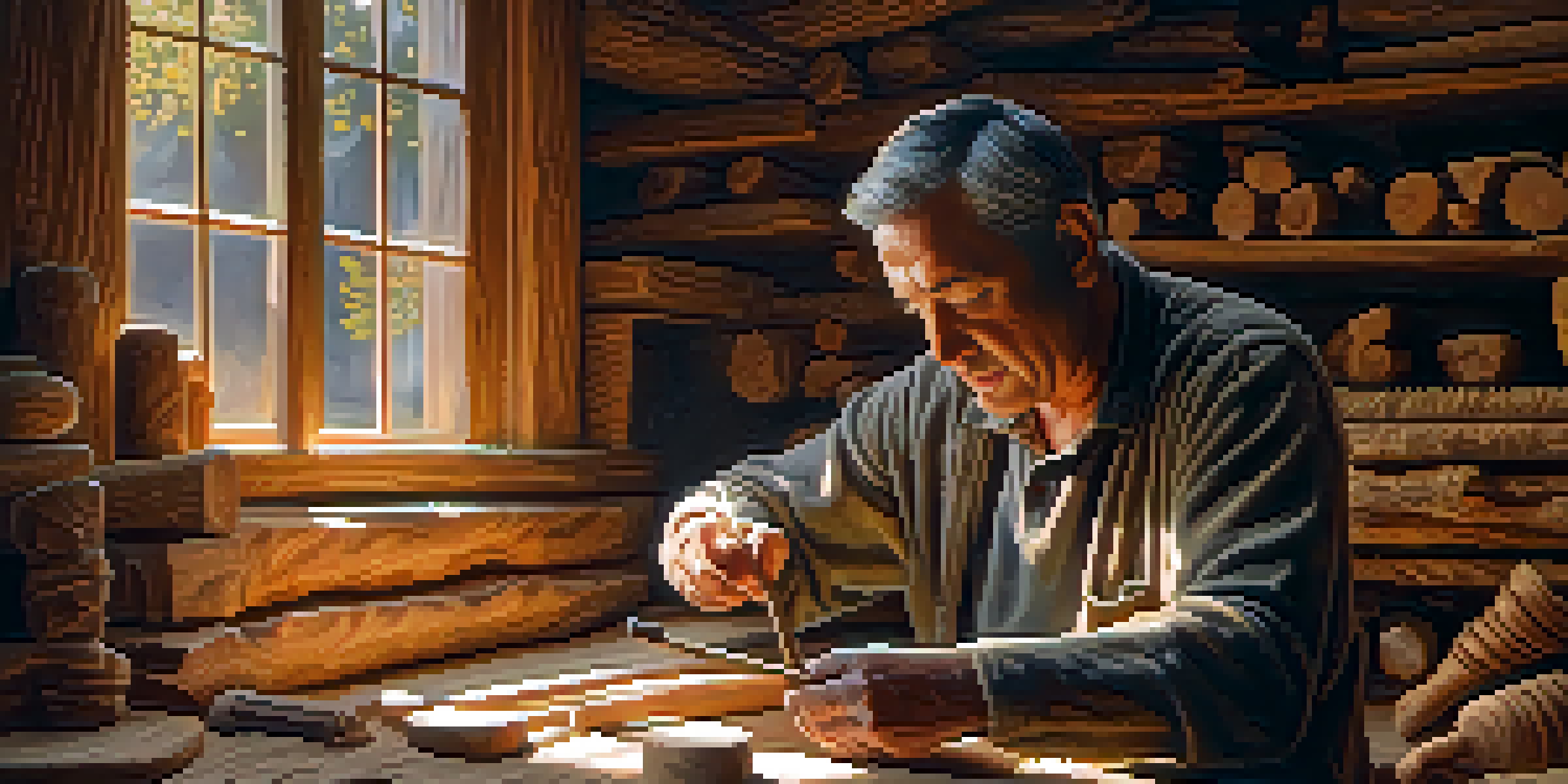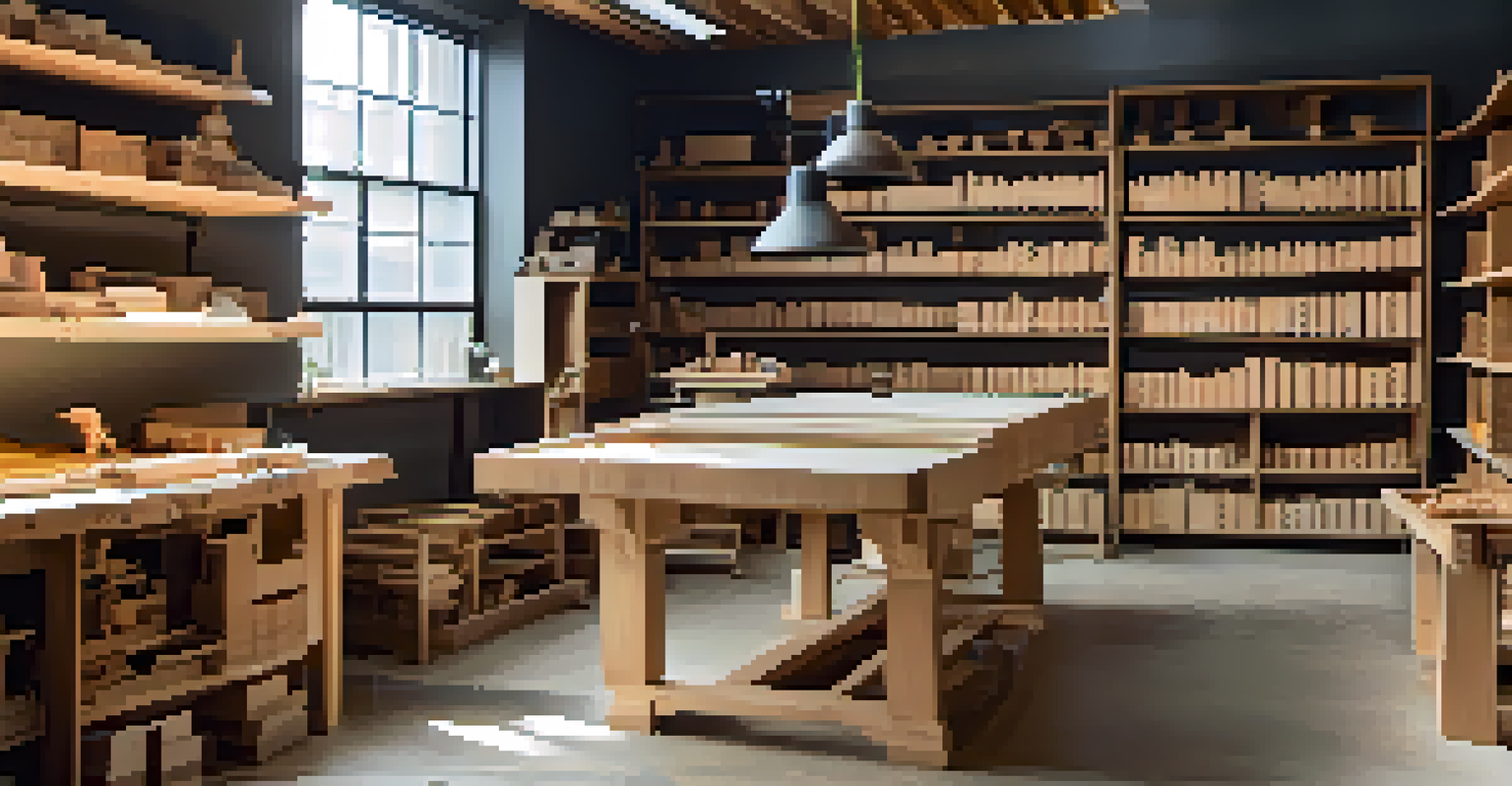Exploring Traditional vs. Modern Carving Techniques in Classes

Understanding Traditional Carving Techniques
Traditional carving techniques have been passed down through generations, often rooted in specific cultures and practices. This form of carving typically involves hand tools like chisels and gouges, requiring a deep understanding of the materials and techniques. Artists using traditional methods appreciate the tactile connection to their work, as they shape each piece with precision and care.
Art is not freedom from discipline, but disciplined freedom.
For example, in wood carving, artisans may use a mallet to strike their chisels, allowing for intricate designs that highlight the wood's natural grain. This process not only requires skill but also patience, as each cut is deliberate and contributes to the final artwork. Many students in art classes find that traditional carving fosters a sense of craftsmanship that can be quite rewarding.
However, traditional techniques can also be time-consuming, which may lead some artists to explore modern approaches. Despite this, understanding traditional methods can greatly enhance one's overall skill set and appreciation for the art of carving.
The Rise of Modern Carving Techniques
Modern carving techniques have embraced technology and new materials, allowing artists to experiment in ways that traditional methods do not. Tools like rotary tools, lasers, and CNC machines can create intricate designs with speed and precision, making it easier for beginners to produce professional-looking results. This shift has opened up carving to a broader audience, making it accessible to those who may have felt intimidated by traditional techniques.

For instance, students in art classes can now use 3D modeling software to visualize their designs before ever touching their material. This approach not only enhances creativity but also reduces the risk of costly mistakes. As a result, many find that modern techniques encourage experimentation, pushing the boundaries of what carving can be.
Traditional Techniques Build Skills
Mastering traditional carving techniques enhances hand-eye coordination and provides a deep understanding of materials.
While modern methods may lack the tactile experience of hand-carving, they offer their own unique set of advantages. Artists often find that combining both traditional and modern techniques can lead to innovative results and a richer artistic expression.
Key Differences Between Traditional and Modern Techniques
One of the most significant differences between traditional and modern carving techniques is the tools used. Traditional artists rely on hand tools, which require significant physical effort and skill to master, while modern carving often leverages power tools that can expedite the process. This fundamental difference shapes not only the approach to carving but also the final outcome of the artwork.
The process of creation is a journey of learning and exploration, where tradition meets innovation.
Additionally, the learning curves differ dramatically. Traditional techniques often necessitate a longer period of practice to achieve proficiency, as each movement must be refined over time. Conversely, modern techniques may allow students to produce satisfactory results more quickly, which can be incredibly motivating for beginners eager to see their progress.
However, the choice between traditional and modern methods often comes down to personal preference and artistic goals. Some artists find joy in the slow, meditative process of traditional carving, while others thrive on the immediacy and innovation offered by modern techniques.
Benefits of Learning Traditional Techniques
Learning traditional carving techniques provides a strong foundation for any aspiring artist. These skills help to develop hand-eye coordination and an understanding of materials that is invaluable in any artistic endeavor. In art classes, instructors often emphasize the importance of mastering these techniques as a way to appreciate the history and culture behind carving.
Moreover, traditional techniques can foster creativity by encouraging artists to think critically about their designs and methods. Students often find that working with their hands in a tactile manner allows for a deeper connection to their artwork. This engagement can lead to unique expressions that may not emerge through modern methods alone.
Modern Methods Encourage Innovation
Utilizing modern carving techniques with tools like lasers and CNC machines fosters creativity and allows for quick experimentation.
Additionally, traditional carving techniques promote a sense of pride in craftsmanship. Completing a piece entirely by hand can be immensely satisfying, providing artists with a tangible connection to their work that often resonates more deeply than a digitally produced piece.
Advantages of Modern Carving Techniques
One of the standout advantages of modern carving techniques is the speed at which artists can produce work. Power tools and machines can execute intricate designs in a fraction of the time it would take to complete the same piece by hand. This efficiency is particularly appealing in a fast-paced environment like art classes, where students may want to explore multiple projects simultaneously.
Modern techniques also allow for greater precision and consistency in the finished product. This is especially true with tools like laser cutters, which can replicate designs with exact accuracy. Beginners often find this accuracy reassuring, as it helps build their confidence in their carving abilities.
Furthermore, modern techniques encourage collaboration and innovation within the artistic community. Artists can now share designs and techniques through digital platforms, enabling a flow of ideas that can lead to groundbreaking new works. This collaborative spirit is a refreshing aspect of contemporary carving that inspires many students today.
Combining Traditional and Modern Techniques
Many artists today are discovering the benefits of blending traditional and modern carving techniques. By combining the craftsmanship of hand tools with the efficiency of power tools, they can create unique pieces that reflect their personal style and artistic vision. This hybrid approach allows for a deeper exploration of materials and techniques, enriching the creative process.
In art classes, students are often encouraged to experiment with both techniques, fostering an environment of innovation and creativity. For instance, an artist might start a project using traditional hand-carving methods and finish it with modern tools for detail and precision. This combination can lead to stunning results that celebrate the best of both worlds.
Combining Techniques Enhances Art
Blending traditional and modern carving methods leads to unique artistic expressions and a richer creative process.
Additionally, this blending of techniques can help students appreciate the history of carving while also pushing the boundaries of contemporary practice. It encourages a mindset of exploration, where tradition and innovation coexist, inspiring artists to continually evolve their craft.
Choosing the Right Technique for Your Artistic Goals
When it comes to choosing between traditional and modern carving techniques, it's essential to consider your artistic goals and personal preferences. If you're drawn to the history and craftsmanship of traditional methods, investing time in mastering these techniques may be the best path for you. Many artists find that the slow, deliberate process of hand-carving provides a sense of fulfillment that resonates deeply.
On the other hand, if your focus is on speed and experimentation, modern techniques may better align with your objectives. These methods can help you produce work quickly and allow for more exploration and innovation in your art. Art classes often provide the opportunity to try both approaches, helping students find their niche.

Ultimately, the best choice may be a combination of both techniques that suits your style and allows for artistic growth. Embracing the strengths of traditional and modern carving can lead to a rich and rewarding artistic journey.